Investigating the Effect of Fine Particulate Matter (PM2.5) Emission Reduction on Surface-Level Ozone (O3) during Summer across the UK
Abstract
1. Introduction
2. Materials and Methods
2.1. Measurement Data
2.2. Monitoring Sites
2.3. Data Analysis
3. Results and Discussion
4. Conclusions
Author Contributions
Funding
Institutional Review Board Statement
Informed Consent Statement
Data Availability Statement
Acknowledgments
Conflicts of Interest
Appendix A
| Alkanes | Alkenes | Alkyne | Aromatic |
| Ethane | Ethene | Ethyne | benzene |
| Propane | Propene | toluene | |
| iso-butane | 1-butene | ethylbenzene | |
| n-butane | trans-2-butene | m+p-xylene | |
| iso-pentane | cis-2-butene | o-xylene | |
| n-pentane | 1,3-butadiene | 1,2,3-trimethylbenzene | |
| 2-methylpentane | trans-2-pentene | ||
| n-hexane | 1-pentene | ||
| n-heptane | isoprene | ||
| iso-octane | cis-2-pentene | ||
| n-octane | |||
| 3-methylpentane |
Appendix B

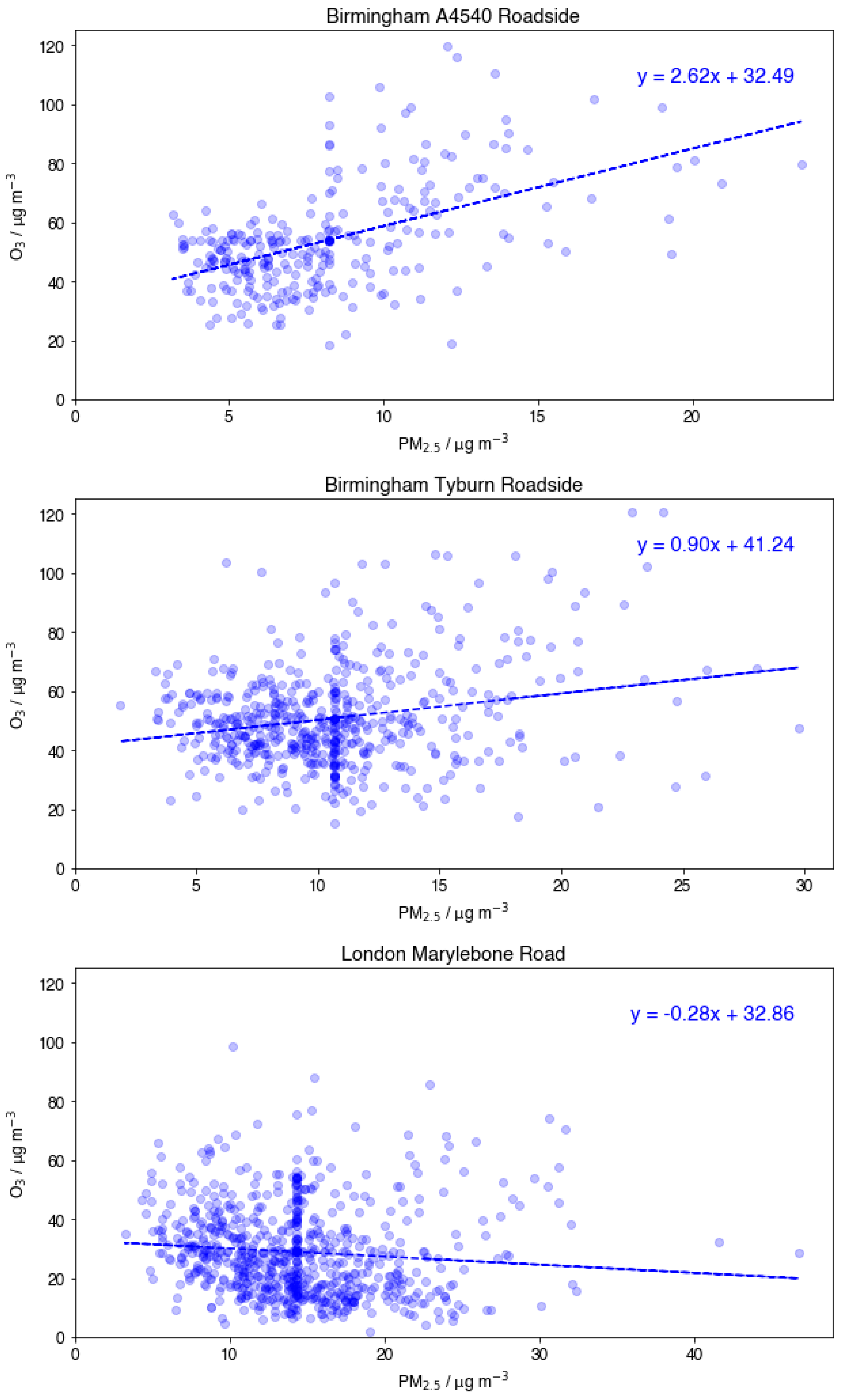
References
- Oh, M.-S.; Park, C.K. Regional source apportionment of PM2.5 in Seoul using Bayesian multivariate receptor model. J. Appl. Stat. 2022, 49, 738–751. [Google Scholar] [CrossRef] [PubMed]
- Samek, L.; Stegowski, Z.; Furman, L.; Styszko, K.; Szramowiat, K.; Fiedor, J. Quantitative assessment of PM2.5 sources and their seasonal variation in Krakow. Water Air Soil Pollut. 2017, 228, 290. [Google Scholar] [CrossRef] [PubMed]
- Chow, W.S.; Liao, K.; Huang, X.H.H.; Leung, K.F.; Lau, A.K.H.; Yu, J.Z. Measurement report: The 10-year trend of PM2.5 major components and source tracers from 2008 to 2017 in an urban site of Hong Kong, China. Atmos. Chem. Phys. 2022, 22, 11557–11577. [Google Scholar] [CrossRef]
- Philip, S.; Martin, R.V.; Snider, G.; Weagle, C.L.; van Donkelaar, A.; Brauer, M.; Henze, D.K.; Klimont, Z.; Venkataraman, C.; Guttikunda, S.K.; et al. Anthropogenic fugitive, combustion and industrial dust is a significant, underrepresented fine particulate matter source in global atmospheric models. Environ. Res. Lett. 2017, 12, 044018. [Google Scholar] [CrossRef]
- Ditto, J.C.; Joo, T.; Khare, P.; Sheu, R.; Takeuchi, M.; Chen, Y.; Xu, W.; Bui, A.A.T.; Sun, Y.; Ng, N.L.S.; et al. Effects of Molecular-Level Compositional Variability in Organic Aerosol on Phase State and Thermodynamic Mixing Behavior. Environ. Sci. Technol. 2019, 53, 13009. [Google Scholar] [CrossRef] [PubMed]
- McDuffie, E.E.; Martin, R.V.; Spadaro, J.V.; Burnett, R.; Smith, S.J.; O’Rourke, P.; Hammer, M.S.; van Donkelaar, A.; Bindle, L.; Shah, V.; et al. Source sector and fuel contributions to ambient PM2.5 and attributable mortality across multiple spatial scales. Nat. Commun. 2021, 12, 3594. [Google Scholar] [CrossRef] [PubMed]
- Department for Environment Food and Rural Affairs. Air Quality Expert Group, Fina Particulate Matter (PM2.5) in the United Kingdom. Available online: https://uk-air.defra.gov.uk/research/aqeg/ (accessed on 14 May 2024).
- Beekmann, M.; Prévôt, A.S.H.; Drewnick, F.; Sciare, J.; Pandis, S.N.; Denier van der Gon, H.A.C.; Crippa, M.; Freutel, F.; Poulain, L.; Ghersi, V.; et al. In situ, satellite measurement and model evidence on the dominant regional contribution to fine particulate matter levels in the Paris megacity. Atmos. Chem. Phys. 2015, 15, 9577–9591. [Google Scholar] [CrossRef]
- De Meij, A.; Thunis, P.; Bessagnet, B.; Cuvelier, C. The sensitivity of the CHIMERE model to emissions reduction scenarios on air quality in Northern Italy. Atmos. Environ. 2009, 43, 1897–1907. [Google Scholar] [CrossRef]
- Larsen, B.; Gilardoni, S.; Stenström, K.; Niedzialek, J.; Jimenez, J.; Belis, C. Sources for PM air pollution in the Po Plain, Italy: II. Probabilistic uncertainty characterization and sensitivity analysis of secondary and primary sources. Atmos. Environ. 2012, 50, 203–213. [Google Scholar] [CrossRef]
- Hodan, W.M.; Barnard, W.R. Evaluating the Contribution of PM2.5 Precursor Gases and Re-Entrained Road Emissions to Mobile Source PM2.5 Particulate Matter Emissions; MACTEC Federal Programs: Research Triangle Park, NC, USA, 2004. [Google Scholar]
- Zhang, J.; Wei, Y.; Fang, Z. Ozone pollution: A major health hazard worldwide. Front. Immunol. 2019, 10, 2518. [Google Scholar] [CrossRef]
- Nuvolone, D.; Petri, D.; Voller, F. The effects of ozone on human health. Environ. Sci. Poll. Res. 2018, 25, 8074–8088. [Google Scholar] [CrossRef] [PubMed]
- IPCC. Climate Change 2013: The Physical Science Basis. Contribution of Working Group I to the Fifth Assessment Report of the Intergovernmental Panel on Climate Change; Stocker, T.F., Qin, D., Plainer, G.-K., Tignor, M., Allen, S.K., Boschung, J., Nauels, A., Xia, Y., Bex, V., Midgley, P.M., Eds.; Cambridge University Press: Cambridge, UK; New York, NY, USA, 2013. [Google Scholar]
- Juráň, S.; Grace, J.; Urban, O. Temporal changes in ozone concentrations and their impact on vegetation. Atmosphere 2021, 12, 82. [Google Scholar] [CrossRef]
- Jenkin, M.E.; Clemitshaw, K.C. Ozone and other secondary photochemical pollutants: Chemical processes governing their formation in the planetary boundary layer. Atmos. Environ. 2000, 34, 2499–2527. [Google Scholar] [CrossRef]
- Colvile, R.N.; Choularton, T.W.; Gallagher, M.W.; Wicks, A.J.; Downer, R.M.; Tyler, B.J.; Storeton-West, K.J.; Fowler, D.; Cape, J.N.; Dollard, G.J.; et al. Observation on great dun fell of the pathways by which oxides of nitrogen are converted to nitrate. Atmos. Environ. 1994, 28, 397–408. [Google Scholar] [CrossRef]
- Van Doren, J.M.; Watson, L.R.; Davidovits, P.; Worsnop, D.R.; Zahniser, M.S.; Kolb, C.E. Temperature dependence of the uptake coefficients of HNO3, HCl and N2O5 by water droplets. J. Phys. Chem. 1990, 94, 3265–3269. [Google Scholar] [CrossRef]
- DeMore, W.B.; Sander, S.P.; Golden, D.M.; Hampson, R.F.; Kurylo, M.J.; Howard, C.J.; Ravishankara, A.R.; Kolb, C.E.; Molina, M.J. Chemical Kinetics and Photochemical Data for Use in Stratospheric Modeling, Evaluation Number 12; JPL Publication 97-4; Jet Propulsion Laboratory, National Aeronautics and Space Administration: Pasadena, CA, USA, 1997; 266p. [Google Scholar]
- Li, K.; Jacob, D.J.; Liao, H.; Shen, L.; Zhang, Q.; Bates, K.H. Anthropogenic drivers of 2013–2017 trends in summer surface ozone in China. Proc. Nat. Acad. Sci. USA 2019, 116, 422–427. [Google Scholar] [CrossRef] [PubMed]
- Department for Environment Food and Rural Affairs Air Quality Strategy: Framework for Local Authority Delivery. 2023. Available online: https://assets.publishing.service.gov.uk/media/64e8963d635870000d1dbf9d/Air_Quality_Strategy_Web.pdf (accessed on 15 May 2024).
- Department for Environment Food and Rural Affairs National Statistics. Particulate Matter (PM10/PM2.5). Available online: https://www.gov.uk/government/statistics/air-quality-statistics/concentrations-of-particulate-matter-pm10-and-pm25 (accessed on 15 May 2024).
- Air Quality Expert Group. Ozone in the UK—Recent Trends and Future Projections. 2021. Available online: https://uk-air.defra.gov.uk/assets/documents/reports/cat09/2112200932_Ozone_in_the_UK_Recent_Trends_and_Future_Projections.pdf (accessed on 15 May 2024).
- Holland, R.; Khan, M.A.H.; Derwent, R.G.; Lynch, J.; Ahmed, F.; Grace, S.; Bacak, A.; Shallcross, D.E. Gas-phase kinetics, POCPs and an investigation of the contributions of VOCs to urban ozone production in the UK. Int. J. Chem. Kinet. 2023, 55, 350–364. [Google Scholar] [CrossRef]
- Diaz, F.M.R.; Khan, M.A.H.; Shallcross, B.M.A.; Shallcross, E.D.G.; Vogt, U.; Shallcross, D.E. Ozone trends in the United Kingdom over the last 30 years. Atmosphere 2020, 11, 534. [Google Scholar] [CrossRef]
- Department for Environment Food & Rural Affairs National Air Quality Data Archive. UK Air Information Resource. Available online: https://uk-air.defra.gov.uk/data/data_selector_service#mid (accessed on 15 May 2024).
- Department for Environment Food & Rural Affairs Automatic Urban and Rural Network (AURN). Available online: https://uk-air.defra.gov.uk/networks/network-info?view=aurn (accessed on 15 May 2024).
- Department for Environment Food & Rural Affairs. “Particulate Matter (PM2.5 Targets) in the Environment Act: Monitoring Assessment Methods. Available online: https://uk-air.defra.gov.uk/networks/monitoring-methods?view=PM-Environment-Act-MonitoringMethods (accessed on 15 May 2024).
- Department for Environment Food & Rural Affairs. The Air Quality Data Validation and Ratification Process. 2017. Available online: https://uk-air.defra.gov.uk/assets/documents/Data_Validation_and_Ratification_Process_Apr_2017.pdf (accessed on 15 May 2024).
- Department for Environment Food & Rural Affairs. UK AIR Glossary. Available online: https://uk-air.defra.gov.uk/air-pollution/glossary (accessed on 15 May 2024).
- Department for Environment Food & Rural Affairs. Automatic Hydrocarbon Network. Available online: https://uk-air.defra.gov.uk/networks/network-info?view=hc (accessed on 15 May 2024).
- Department for Environment Food & Rural Affairs. Site Information for London Marylebone Road(UKA00315). Available online: https://uk-air.defra.gov.uk/networks/site-info?uka_id=UKA00315&search=View+Site+Information&action=site&provider=archive (accessed on 15 May 2024).
- Wood, C.R.; ApSimon, H.; Arnold, S.; Balogun, A.A.; Barlow, J.F.; Belcher, S.E.; Britter, R.E.; Cheng, H.; Colvile, R.N.; Dobre, A.; et al. Dispersion experiments in central London: The 2007 DAPPLE project. Bull. Am. Meteorol. Soc. 2009, 90, 955–969. [Google Scholar] [CrossRef]
- Martin, D.; Price, C.S.; Nickless, G.; Britter, R.E.; Londou, A.-N.; Neophytou, M.K.; Cheng, H.; Robins, A.G.; Dobre, A.; Belcher, S.E.; et al. Urban tracer dispersion experiments in London (DAPPLE) 2003: Field studies and comparisons with empirical prediction. Atmos. Sci. Lett. 2010, 11, 241–248. [Google Scholar] [CrossRef]
- Balogun, A.; Tomlin, A.; Wood, C.; Barlow, J.; Belcher, S.; Smalley, R.; Lingard, J.; Arnold, S.; Dobre, A.; Robins, A.; et al. In-street wind direction variability in the vicinity of a busy intersection in Central London I. Bound. Layer Meteorol. 2010, 136, 489–513. [Google Scholar] [CrossRef][Green Version]
- Martin, D.; Price, C.S.; Nickless, G.; Britter, R.E.; Londou, A.-N.; Neophytou, M.K.; Cheng, H.; Robins, A.G.; Dobre, A.; Belcher, S.E.; et al. Urban tracer dispersion experiments during the second DAPPLE field campaign in London 2004. Atmos. Environ. 2010, 44, 3043–3052. [Google Scholar] [CrossRef]
- Zhang, C.; Stevenson, D. Characteristic changes of ozone and its precursors in London during COVID-19 lockdown and the ozone surge season analysis. Atmos. Environ. 2022, 273, 118980. [Google Scholar] [CrossRef] [PubMed]
- Kalisa, E.; Fadlallah, S.; Amani, M.; Nahayo, L.; Habiyaremye, G. Temperature and air pollution relationship during heatwaves in Birmingham, UK. Sustain. Cities Soc. 2018, 43, 111–120. [Google Scholar] [CrossRef]
- Department for Environment Food & Rural Affairs. Site Information for Birmingham A4540 Roadside(UKA00626). Available online: https://uk-air.defra.gov.uk/networks/site-info?uka_id=UKA00626&search=View+Site+Information&action=site&provider=archive (accessed on 15 May 2024).
- Garrido-Perez, J.M.; Ordóñez, C.; García-Herrera, R.; Schnell, J.L. The differing impact of air stagnation on summer ozone across Europe. Atmos. Environ. 2019, 219, 117062. [Google Scholar] [CrossRef]
- Wang, T.; Xue, L.; Brimblecombe, P.; Lam, Y.F.; Li, L.; Zhang, L. Ozone pollution in China: A review of concentrations, meteorological influences, chemical precursors, and effects. Sci. Total Environ. 2017, 575, 1582–1596. [Google Scholar] [CrossRef] [PubMed]
- Wakeling, D.; Passant, N.R.; Murrells, T.P.; Pang, Y.; Thistlethwaite, G.; Walker, C.; Brown, P.; del Vento, S.; Hunter, R.; Wiltshire, J.; et al. UK Informative Inventory Report (1990 to 2015); DEFRA: London, UK, 2017; pp. 67–76. [Google Scholar]
- Air Quality Expert Group. Fine Particulate Matter (PM2.5) in the United Kingdom. 2012. Available online: https://uk-air.defra.gov.uk/assets/documents/reports/cat11/1212141150_AQEG_Fine_Particulate_Matter_in_the_UK.pdf (accessed on 15 May 2024).
- Holland, R.; Seifert, K.; Saboya, E.; Khan, M.A.H.; Derwent, R.G.; Shallcross, D.E. Elucidating the effects of COVID-19 lockdowns in the UK on the O3-NOx-VOC relationship. Atmosphere 2024, 15, 607. [Google Scholar] [CrossRef]
- Strong, J.; Whyatt, J.D.; Metcalfe, S.E.; Derwent, R.G.; Hewitt, C.N. Investigating the impacts of anthropogenic and biogenic VOC emissions and elevated temperatures during the 2003 ozone episode in the UK. Atmos. Environ. 2013, 74, 393–401. [Google Scholar] [CrossRef]
- Harrison, R.M. Airborne particulate matter. Philos. Trans. R. Soc. A 2020, 378, 20190319. [Google Scholar] [CrossRef]
- Vieno, M.; Heal, M.R.; Williams, M.; Carnell, E.; Nemitz, E.; Stedman, J.; Reis, S. The sensitivities of emissions reductions for the mitigation of UK PM2.5. Atmos. Chem. Phys. 2016, 16, 265–276. [Google Scholar] [CrossRef]
- Shao, M.; Wang, W.; Yuan, B.; Parrish, D.D.; Li, X.; Lu, K.; Wu, L.; Wang, X.; Mo, Z.; Yang, S. Quantifying the role of PM2.5 dropping in variations of ground-level ozone: Inter-comparison between Beijing and Los Angeles. Sci. Total Environ. 2021, 788, 147712. [Google Scholar] [CrossRef] [PubMed]
- Wang, N.; Lyu, X.; Deng, X.; Huang, X.; Jiang, F.; Ding, A. Aggravating O3 pollution due to NOx emission control in eastern China. Sci. Total Environ. 2019, 677, 732–744. [Google Scholar] [CrossRef] [PubMed]
- Sicard, P.; Paoletti, E.; Agathokleous, E.; Araminienė, V.; Proietti, C.; Coulibaly, F.; De Marco, A. Ozone weekend effect in cities: Deep insights for urban air pollution control. Environ. Res. 2020, 191, 110193. [Google Scholar] [CrossRef] [PubMed]
- Amann, M.; Derwent, D.; Forsberg, B.; Hänninen, O.; Hurley, F.; Krzyzanowski, M.; de Leeuw, F.; Liu, S.J.; Mandin, C.; Schneider, J.; et al. Health Risks of Ozone from Long-Range Transboundary Air Pollution; World Health Organization (WHO) Regional Office for Europe: Copenhagen, Denmark, 2008. [Google Scholar]
- Lewis, A.C.; Hopkins, J.R.; Carslaw, D.C.; Hamilton, J.F.; Nelson, B.S.; Stewart, G.; Dernie, J.; Passant, N.; Murrells, T. An increasing role for solvent emissions and implications for future measurements of volatile organic compounds. Philos. Trans. R. Soc. A 2020, 378, 20190328. [Google Scholar] [CrossRef] [PubMed]
- Laxen, D.; Moorcroft, S.; Marner, B.; Laxen, K.; Boulter, P.; Barlow, T.; Harrison, R.; Heal, M. PM2.5 in the UK, Report for Scotland & Northern Ireland Forum for Environmnetal Research (SNIFFER), Edinburgh. December 2010. Available online: https://www.aqconsultants.co.uk/CMSPages/GetFile.aspx?guid=eb3cd7b4-b297-46c5-a382-58113c04a105 (accessed on 16 June 2024).
- Taseiko, O.V.; Mikhailuta, S.V.; Pitt, A.; Lezhenin, A.A.; Zakharov, Y.V. Air pollution dispersion within urban street canyons. Atmos. Environ. 2009, 43, 245–252. [Google Scholar] [CrossRef]
- Tudor, C. Ozone pollution in London and Edinburgh; spatiotemporal characteristics, trends, transport and the impact of COVID-19 control measures. Heliyon 2022, 8, e11384. [Google Scholar] [CrossRef]
- Papadogeorgou, G.; Kioumourtzoglou, M.-A.; Braun, D.; Zanobetti, A. Low levels of air pollution and health: Effect estimates, methodological challenges and future directions. Curr. Environ. Health Rep. 2019, 6, 105–115. [Google Scholar] [CrossRef]



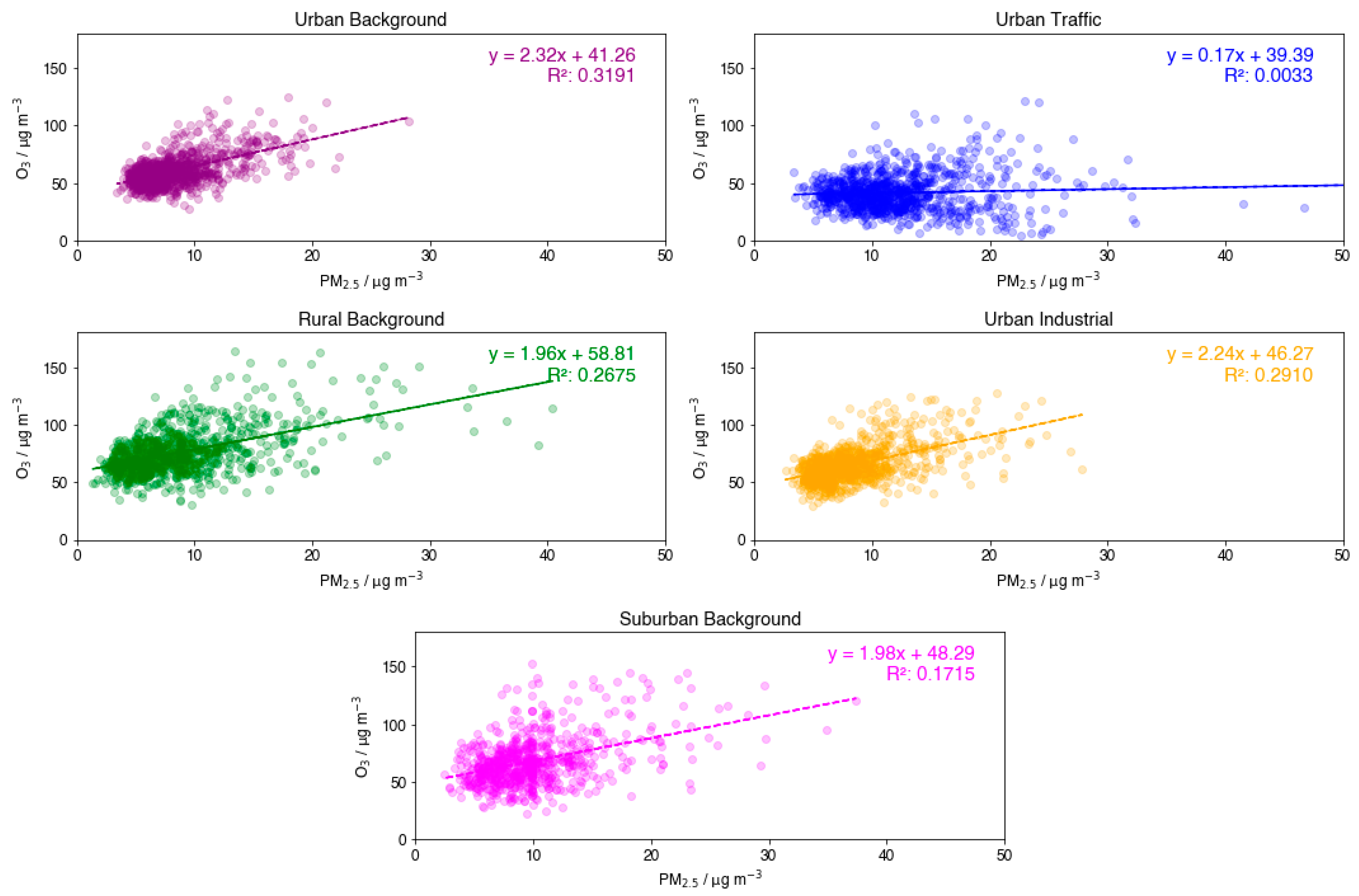
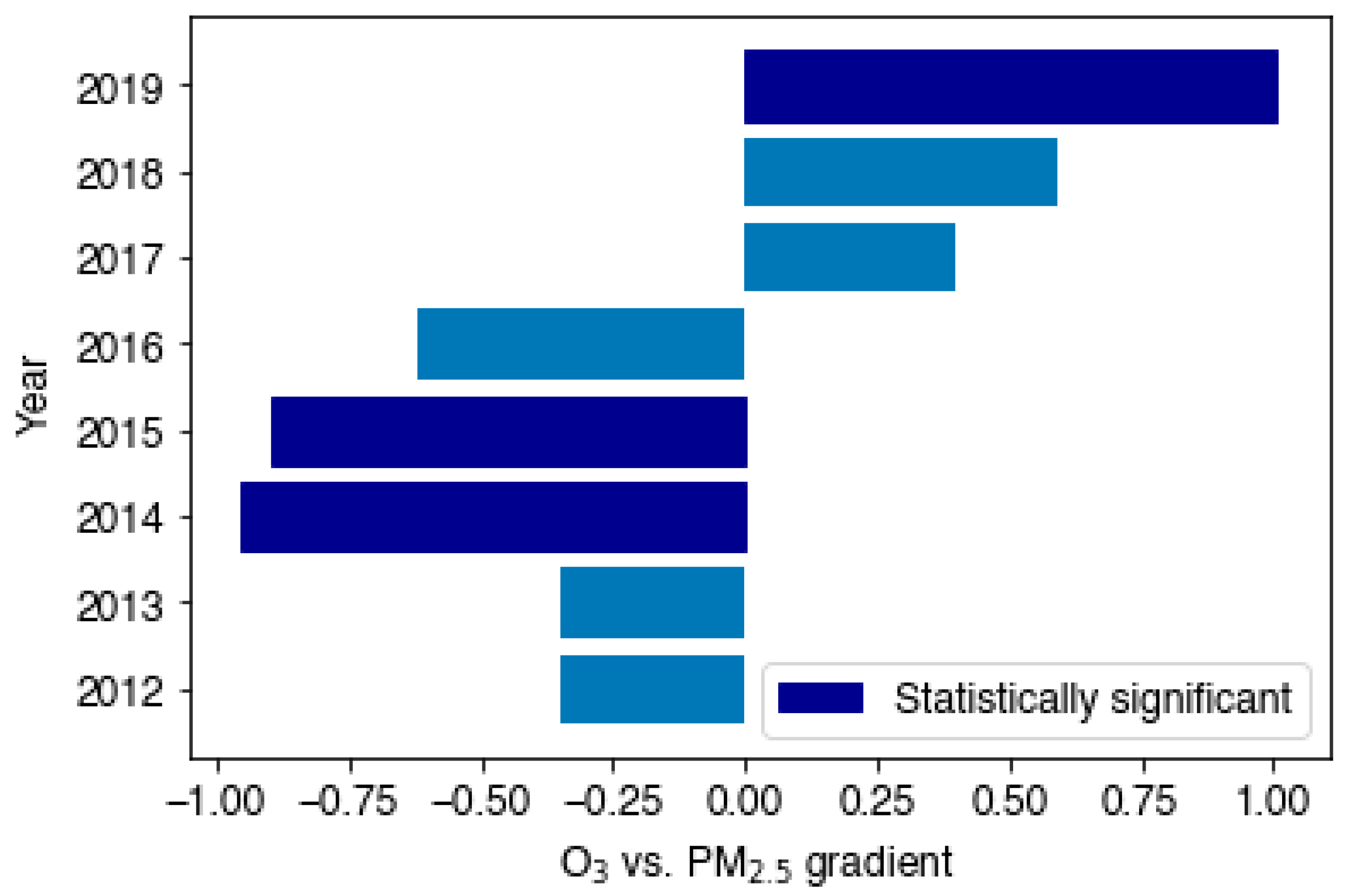

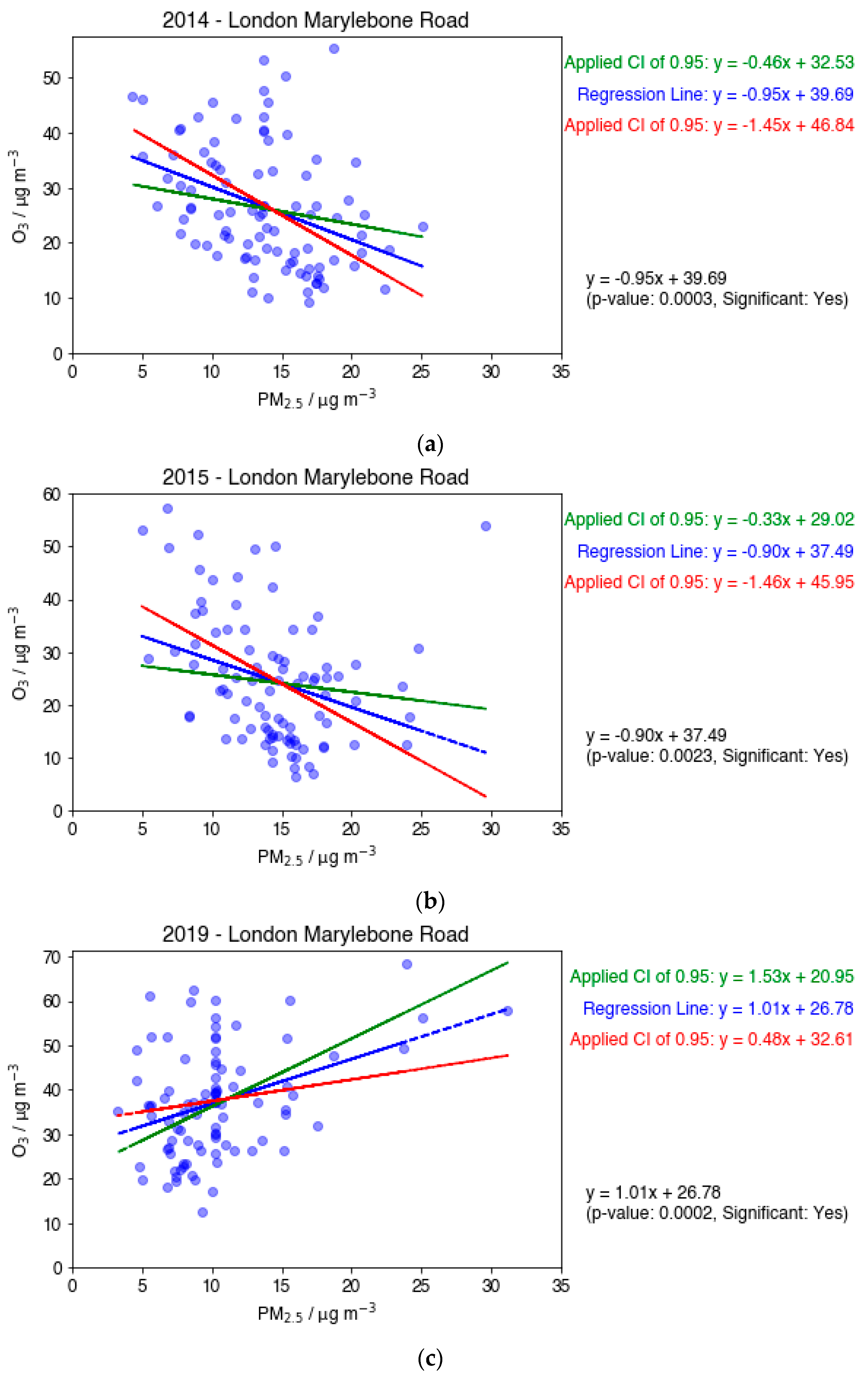

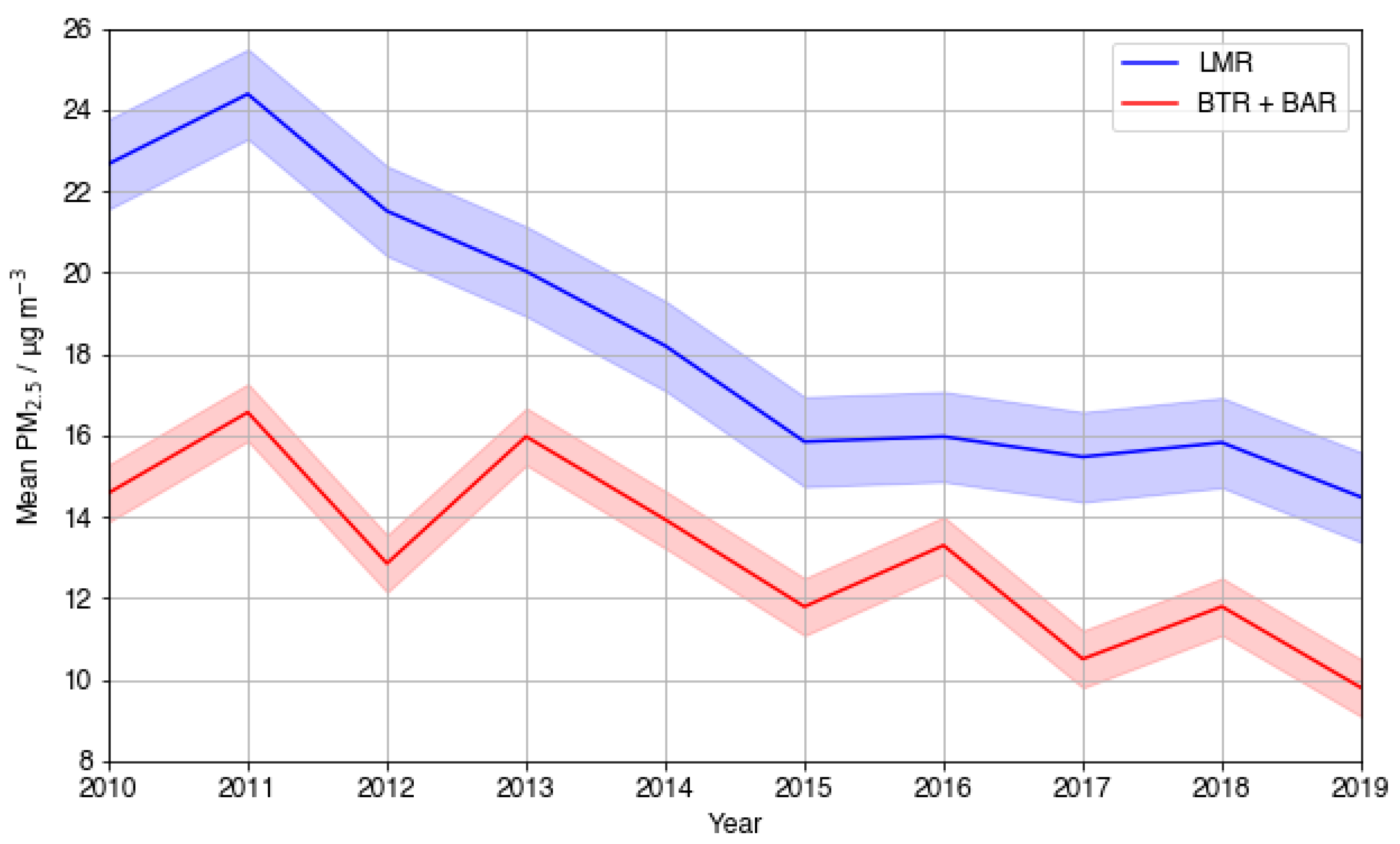
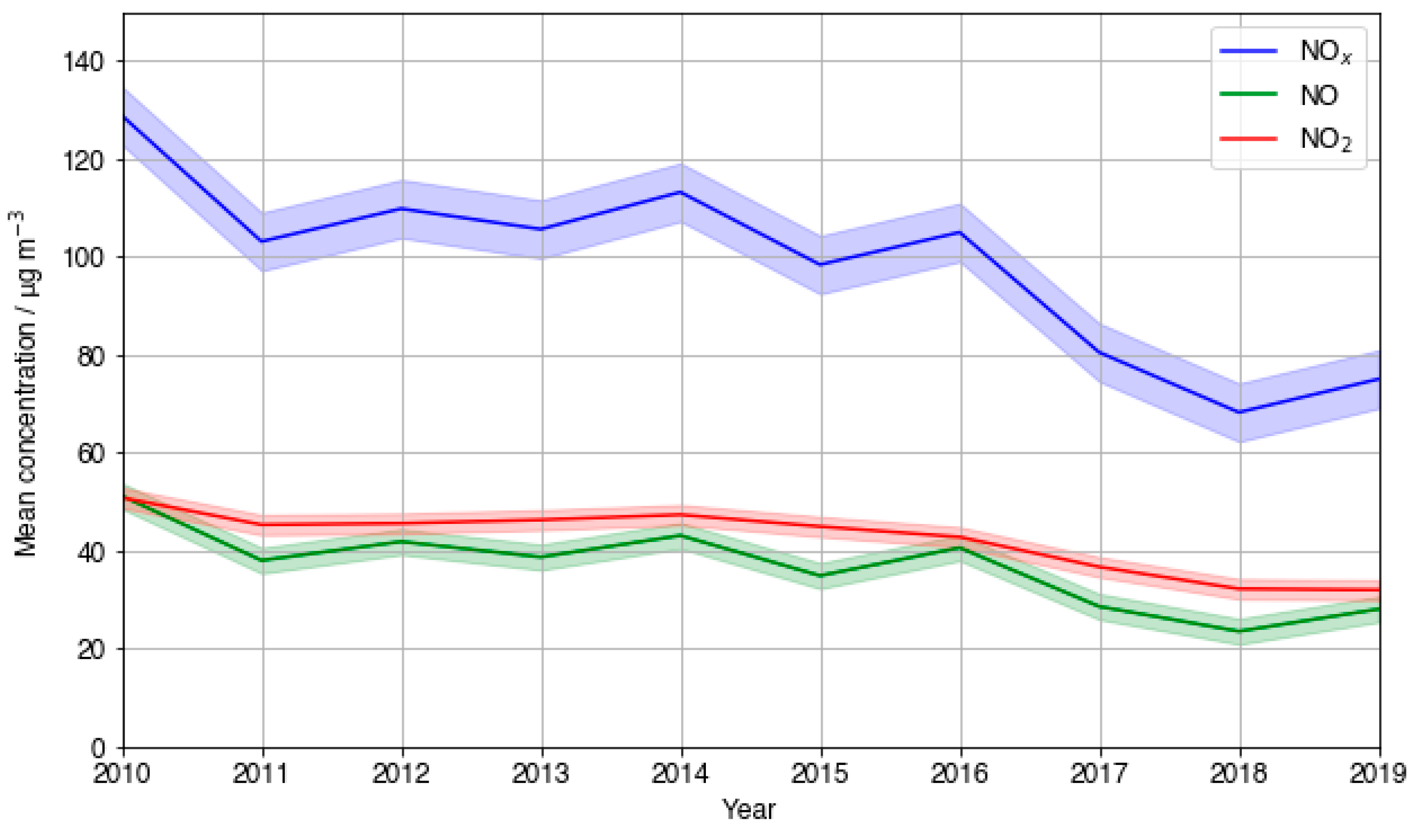
Disclaimer/Publisher’s Note: The statements, opinions and data contained in all publications are solely those of the individual author(s) and contributor(s) and not of MDPI and/or the editor(s). MDPI and/or the editor(s) disclaim responsibility for any injury to people or property resulting from any ideas, methods, instructions or products referred to in the content. |
© 2024 by the authors. Licensee MDPI, Basel, Switzerland. This article is an open access article distributed under the terms and conditions of the Creative Commons Attribution (CC BY) license (https://creativecommons.org/licenses/by/4.0/).
Share and Cite
Curley, L.; Holland, R.; Khan, M.A.H.; Shallcross, D.E. Investigating the Effect of Fine Particulate Matter (PM2.5) Emission Reduction on Surface-Level Ozone (O3) during Summer across the UK. Atmosphere 2024, 15, 733. https://doi.org/10.3390/atmos15060733
Curley L, Holland R, Khan MAH, Shallcross DE. Investigating the Effect of Fine Particulate Matter (PM2.5) Emission Reduction on Surface-Level Ozone (O3) during Summer across the UK. Atmosphere. 2024; 15(6):733. https://doi.org/10.3390/atmos15060733
Chicago/Turabian StyleCurley, Lydia, Rayne Holland, M. Anwar H. Khan, and Dudley E. Shallcross. 2024. "Investigating the Effect of Fine Particulate Matter (PM2.5) Emission Reduction on Surface-Level Ozone (O3) during Summer across the UK" Atmosphere 15, no. 6: 733. https://doi.org/10.3390/atmos15060733
APA StyleCurley, L., Holland, R., Khan, M. A. H., & Shallcross, D. E. (2024). Investigating the Effect of Fine Particulate Matter (PM2.5) Emission Reduction on Surface-Level Ozone (O3) during Summer across the UK. Atmosphere, 15(6), 733. https://doi.org/10.3390/atmos15060733









